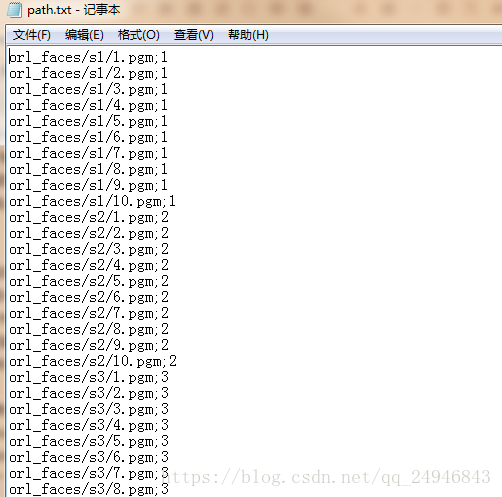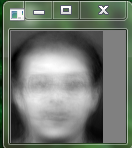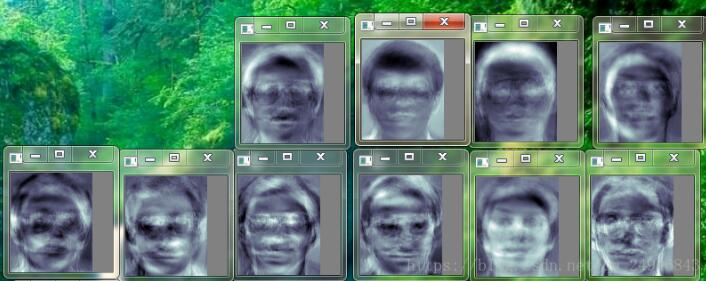您好,登錄后才能下訂單哦!
您好,登錄后才能下訂單哦!
簡要:
EigenFace是基于PCA降維的人臉識別算法,PCA是使整體數據降維后的方差最大,沒有考慮降維后類間的變化。 它是將圖像每一個像素當作一維特征,然后用SVM或其它機器學習算法進行訓練。但這樣維數太多,根本無法計算。我這里用的是ORL人臉數據庫,英國劍橋實驗室拍攝的,有40位志愿者的人臉,在不同表情不同光照下每位志愿者拍攝10張,共有400張圖片,大小為112*92,所以如果把每個像素當做特征拿來訓練的話,一張人臉就有10304維特征,這么高維的數據根本無法處理。所以需要先對數據進行降維,去掉一些冗余的特征。
第一步:將ORL人臉圖片的地址統一放在一個文件里,等會通過對該文件操作,將圖片全部加載進來。
//ofstream一般對文件進行讀寫操作,ifstream一般對文件進行讀操作
ofstream file;
file.open("path.txt");//新建并打開文件
char str[50] = {};
for (int i = 1; i <= 40; i++) {
for (int j = 1; j <= 10; j++) {
sprintf_s(str, "orl_faces/s%d/%d.pgm;%d", i, j, i);//將數字轉換成字符
file << str << endl;//寫入
}
}
得到路勁文件如下圖所示:

第二步:讀入模型需要輸入的數據,即用來訓練的圖像vector<Mat>images和標簽vector<int>labels
string filename = string("path.txt");
ifstream file(filename);
if (!file) {
printf("could not load file");
}
vector<Mat>images;
vector<int>labels;
char separator = ';';
string line,path, classlabel;
while (getline(file,line)) {
stringstream lines(line);
getline(lines, path, separator);
getline(lines, classlabel);
images.push_back(imread(path, 0));
labels.push_back(atoi(classlabel.c_str()));//atoi(ASCLL to int)將字符串轉換為整數型
}
第三步:加載、訓練、預測模型
Ptr<BasicFaceRecognizer> model = EigenFaceRecognizer::create();
model->train(images, labels);
int predictedLabel = model->predict(testSample);
printf("actual label:%d,predict label :%d\n", testLabel, predictedLabel);
補充:
1、顯示平均臉
//計算特征值特征向量及平均值
Mat vals = model->getEigenValues();//89*1
printf("%d,%d\n", vals.rows, vals.cols);
Mat vecs = model->getEigenVectors();//10324*89
printf("%d,%d\n", vecs.rows, vecs.cols);
Mat mean = model->getMean();//1*10304
printf("%d,%d\n", mean.rows, mean.cols);
//顯示平均臉
Mat meanFace = mean.reshape(1, height);//第一個參數為通道數,第二個參數為多少行
normalize(meanFace, meanFace, 0, 255, NORM_MINMAX, CV_8UC1);
imshow("Mean Face", meanFace);

2、顯示前部分特征臉
//顯示特征臉
for (int i = 0; i<min(10, vals.rows); i++) {
Mat feature_vec = vecs.col(i).clone();
Mat feature_face= feature_vec.reshape(1, height);
normalize(feature_face, feature_face, 0, 255, NORM_MINMAX, CV_8UC1);
Mat colorface;
applyColorMap(feature_face, colorface, COLORMAP_BONE);
sprintf_s(win_title, "eigenface%d", i);
imshow(win_title, colorface);
}

3、對第一張人臉在特征向量空間進行人臉重建(分別基于前10,20,30,40,50,60個特征向量進行人臉重建)
//重建人臉
for (int i = min(10, vals.rows); i <min(61, vals.rows); i+=10) {
Mat vecs_space = Mat(vecs, Range::all(), Range(0, i));
Mat projection = LDA::subspaceProject(vecs_space, mean, images[0].reshape(1, 1));//投影到子空間
Mat reconstruction = LDA::subspaceReconstruct(vecs_space, mean, projection);//重建
Mat result = reconstruction.reshape(1, height);
normalize(result, result, 0, 255, NORM_MINMAX, CV_8UC1);
//char wintitle[40] = {};
sprintf_s(win_title, "recon face %d", i);
imshow(win_title, result);
}

完整代碼如下:
#include<opencv2\opencv.hpp>
#include<opencv2\face.hpp>
using namespace cv;
using namespace face;
using namespace std;
char win_title[40] = {};
int main(int arc, char** argv) {
namedWindow("input",CV_WINDOW_AUTOSIZE);
//讀入模型需要輸入的數據,用來訓練的圖像vector<Mat>images和標簽vector<int>labels
string filename = string("path.txt");
ifstream file(filename);
if (!file) { printf("could not load file"); }
vector<Mat>images;
vector<int>labels;
char separator = ';';
string line,path, classlabel;
while (getline(file,line)) {
stringstream lines(line);
getline(lines, path, separator);
getline(lines, classlabel);
//printf("%d\n", atoi(classlabel.c_str()));
images.push_back(imread(path, 0));
labels.push_back(atoi(classlabel.c_str()));//atoi(ASCLL to int)將字符串轉換為整數型
}
int height = images[0].rows;
int width = images[0].cols;
printf("height:%d,width:%d\n", height, width);
//將最后一個樣本作為測試樣本
Mat testSample = images[images.size() - 1];
int testLabel = labels[labels.size() - 1];
//刪除列表末尾的元素
images.pop_back();
labels.pop_back();
//加載,訓練,預測
Ptr<BasicFaceRecognizer> model = EigenFaceRecognizer::create();
model->train(images, labels);
int predictedLabel = model->predict(testSample);
printf("actual label:%d,predict label :%d\n", testLabel, predictedLabel);
//計算特征值特征向量及平均值
Mat vals = model->getEigenValues();//89*1
printf("%d,%d\n", vals.rows, vals.cols);
Mat vecs = model->getEigenVectors();//10324*89
printf("%d,%d\n", vecs.rows, vecs.cols);
Mat mean = model->getMean();//1*10304
printf("%d,%d\n", mean.rows, mean.cols);
//顯示平均臉
Mat meanFace = mean.reshape(1, height);//第一個參數為通道數,第二個參數為多少行
normalize(meanFace, meanFace, 0, 255, NORM_MINMAX, CV_8UC1);
imshow("Mean Face", meanFace);
//顯示特征臉
for (int i = 0; i<min(10, vals.rows); i++) {
Mat feature_vec = vecs.col(i).clone();
Mat feature_face= feature_vec.reshape(1, height);
normalize(feature_face, feature_face, 0, 255, NORM_MINMAX, CV_8UC1);
Mat colorface;
applyColorMap(feature_face, colorface, COLORMAP_BONE);
sprintf_s(win_title, "eigenface%d", i);
imshow(win_title, colorface);
}
//重建人臉
for (int i = min(10, vals.rows); i <min(61, vals.rows); i+=10) {
Mat vecs_space = Mat(vecs, Range::all(), Range(0, i));
Mat projection = LDA::subspaceProject(vecs_space, mean, images[0].reshape(1, 1));
Mat reconstruction = LDA::subspaceReconstruct(vecs_space, mean, projection);
Mat result = reconstruction.reshape(1, height);
normalize(result, result, 0, 255, NORM_MINMAX, CV_8UC1);
//char wintitle[40] = {};
sprintf_s(win_title, "recon face %d", i);
imshow(win_title, result);
}
waitKey(0);
return 0;
}
以上就是本文的全部內容,希望對大家的學習有所幫助,也希望大家多多支持億速云。
免責聲明:本站發布的內容(圖片、視頻和文字)以原創、轉載和分享為主,文章觀點不代表本網站立場,如果涉及侵權請聯系站長郵箱:is@yisu.com進行舉報,并提供相關證據,一經查實,將立刻刪除涉嫌侵權內容。